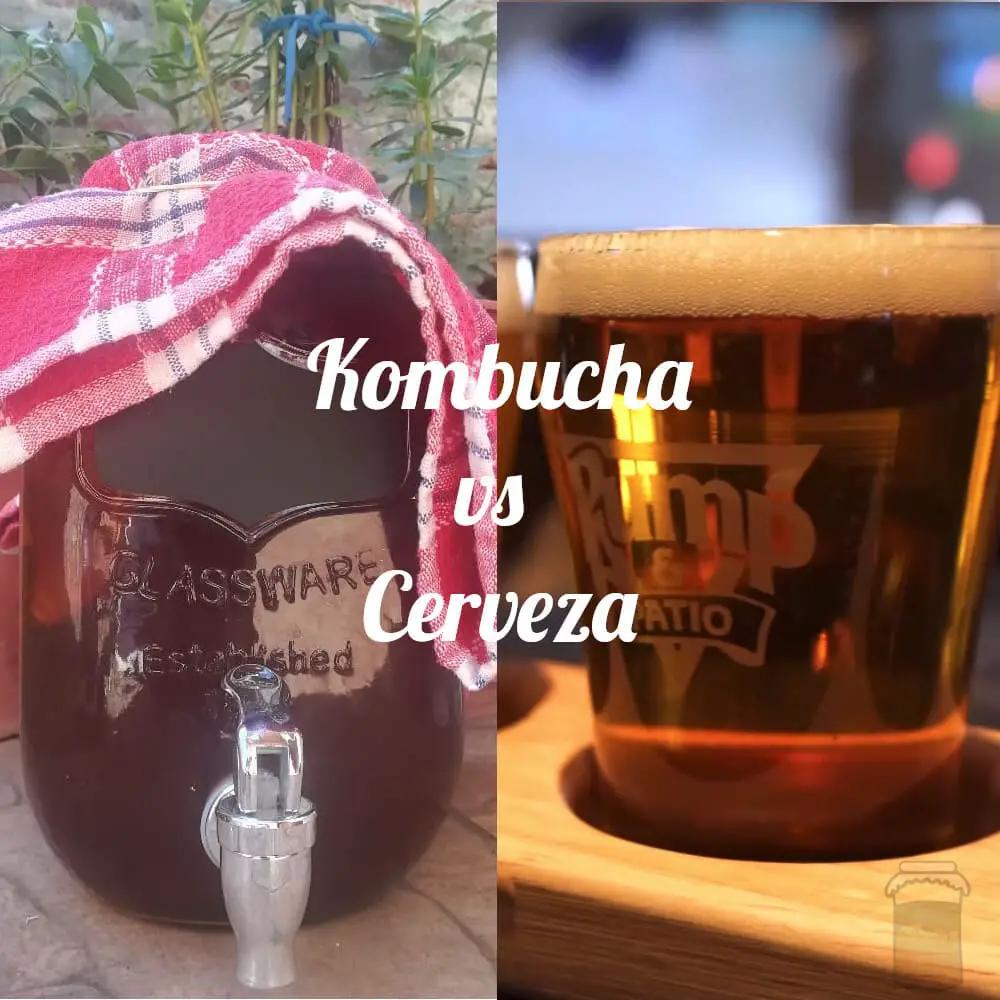Some may already be wondering why we are going to compare kombucha and beer, and the reality is that although it may not seem like it, they have some things in common, such as and without spoiler spirits, both are considered as ancestral fermented drinks, and it is the point that begins to be comparative kombucha vs beer
Currently, consumers who seek the need to take care of their body with exercises and nourish it in a healthy way have turned kombucha as the preference, for the content of nutrients it has and that differs in turn from what beer provides.
Beer apart from being a very old drink has been preferred by many consumers for its alcohol content and its refreshing bitter and sparkling taste, whose social impact began since it was discovered. This drink was complemented in many diets that were generally poor in calories and was consumed for its high caloric level in which it provided energy for the body.
These two drinks are elementally important for their high consumption worldwide and the different benefits they bring to the body for being fermented beverages, so the differences between these two products in terms of fermentation, ingredients, microorganisms, elaboration process and benefits will be described in more detail.
What do beer and kombucha have in common?
Both drinks use live microorganisms to achieve fermentation and transform sugar into alcohol and carbon dioxide. Among these microorganisms is one in common that is the yeast Schizosaccharomyces cerevisiae, responsible for initiating the fermentation process.
In both drinks, the contribution of lipids and proteins is similar, with a negligible contribution. Both also have a slightly acidic taste and an effervescent sensation, much more noticeable in beer.
And well, as we told you, both beer and kombucha are classified within fermented beverages.
What are the benefits of beer and kombucha?
It is important to note that the potential benefits of beer are observed only when consumption is moderate. Possible benefits are:
- Reduces the chance of heart disease.
- They contain antioxidants that help eliminate free radicals through urine.
- It is a diuretic.
- It helps improve anemia by containing iron and folic acid.
- It has been scientifically proven that after moderate consumption of beer, HDL-cholesterol (good cholesterol) increases in the blood, which is associated with a lower risk of ischemic heart disease, that is, heart attack. [1]
- Influences the strengthening of the immune system.
Contraindications of beer and kombucha
In kombucha in general, this drink is not recommended in immunosuppressed patients, as there have been some reports where kombucha is involved with opportunistic infections, although this requires further investigation. [2]
As for beer there are diseases in which if the consumer presents it can not ingest this drink such as liver cirrhosis or some disease of the liver or pancreas if you have heart failure, if you are addicted to alcohol and you are under restriction therapy or if you take antidepressant medications and antibiotics. [3]
Both drinks are prohibited in pregnant women and children under 12 years of age.
Recommended dose to consume beer and kombucha.
Kombucha can be consumed with a daily intake of “120 to 360 ml” distributed before the main meals. In case of diabetes, consumption can be in less quantity per day, so as not to alter blood glucose levels.
You can review our articles on kombucha and diabetes or the recommended daily dose by clicking on the link.
As for beer, the recommendations of the Ministry of Health for low-risk consumption are: ≤ 4 UBEs daily for men (4 beers) and 2 UBEs (2 beers) daily for women at any time of the day or ≤ 28 UBE/week (5 days a week) in men and 17 UBE/week in women. [4]
Alcohol consumption is measured in UBE (Standard Drink Unit equivalent to 10 g of alcohol).
Are the probiotics in beer and kombucha the same?
Kombucha and beer contain live non-pathogenic microorganisms that can be bacteria and yeasts for the fermentation of these two drinks.
The strains of yeasts most used in the manufacture of beer, are those corresponding to the species Schizosaccharomyces cerevisiae in which it must develop in the absence of oxygen so that the production of ethanol is correct but does not contain probiotics.
In the case of kombucha, non-pathogenic living microorganisms are related symbiotically, aerobic microorganisms such as bacteria and yeasts especially. The probiotics associated with kombucha are some strains of Lactobacillus or bacteria of the Acetobacter strains.
Main differences: kombucha vs beer:
Here we will describe the characteristics of the two drinks in view of the fact that both products have differences between them.
Origin:
Kombucha comes from the Asian continent, exactly from China.
As the story goes, its origin goes back to the Middle East.
Raw material and its preparation:
In kombucha, the raw material is green or black tea and sugar.
The elaboration process: a symbiotic culture of bacteria and yeast is added to this liquid, placed in a glass container covered with a cloth that allows air circulation without letting dust or insects enter and leaving the mixture to rest for a week or more.
In beer, the raw material is wheat, barley malt, and hops.
The elaboration process: it starts through 7 processes, the first through the malting of the barley, grinding and maceration, filtration of the wort that is the sugary liquid of the barley, cooking, fermentation of the beer through the yeast, maturation and final packaging. [5]
Microorganisms present:
In kombucha, the bacteria present are: Acetobacter xylinum, Gluconobacter bluconicum. And of the yeasts identified as: Schizosaccharomyces pombe, Schizosaccharomyces cerevisiae, Zygosaccharon bailii, Kloecera apiculata, Brettanomyces bruxellensis, Brettanomyces lambicus, Brettanomyces Custersii, candida stellata.
As for beer, there are two types of yeast: Schizosaccharomyces cerevisiae used to ferment beer and Saccharomyces pastorianus, a hybrid that originated from the yeasts, Saccharomyces cerevisiae and Saccharomyces eubayanus.
Fermentation conditions:
In kombucha, it is fermented with an average ambient temperature of 21 to 27 ° C that require for 7 to 15 days maximum up to 21 days approximately of time to finish fermenting.
As for beer is produced through 2 types of fermentation (7)
- High fermentation: with an initial temperature of 18 to 24 ° C that require for a time of 3 to 4 days, you can reach temperatures of 20 to 25 ° C.
- Low fermentation: with a temperature of 7 to 14 ° C with a time of 3 to 5 days, you can reach a maximum of 10 to 15 ° C.
As for nutrients:
In kombucha, it stands out for its content of vitamins such as: B1 (thiamine), B2 (riboflavin) and B3 (niacin) and high in vitamin C (ascorbic acid), essential oil and minerals such as magnesium, zinc, phosphorus, iodine, polyphenols, flavonoids, and xanthine (caffeine).
As for beer, it contains B vitamins, such as biotin, nicotinic acid, pantotheic acid, pyridoxine, riboflavin, thiamine, folic acid, flavenols and vitamin B12, 3gr of protein, 300 to 400 Kcal per liter of beer.
As for the taste, aroma, and color.
As for kombucha when made with black tea, the presence of theaflavins that are coloring compounds produced during its oxidation gives the color of reddish-brown to black to this drink and for its elaboration it is very aromatic with astringent flavor.
As for beer, the presence of the hop gland contains essential oils that give the acid flavor to beer and sparkling, ranging from yellow to amber by oxidized polyphenols and has no aroma.
In the texture
Both being drinks are liquid textured and somewhat foamy.
We will clarify some of the main differences in a comparative style chart to make it clearer and more concise for readers.
| Characteristics | Beer | Kombucha |
| Origin | Middle East | China |
| Raw material | Malta, wheat, hops, and water | Black or green tea and sugar |
| Microorganisms | yeast | Bacteria and yeasts |
| Fermentation time | 3 to 5 days | 7 to 15 days |
| Fermentation temperature | 7 to 25°C | 21 to 27°C |
| Nutrients | High in calories | Low calorie |
| Taste | Bitter | Slightly acidic and less sweet |
| Aroma | No aroma | Slightly vinegary |
| Colour | Yellow – amber | Brown or reddish |
| Texture | Liquid | Liquid |
| Composition | Liquidates by the presence of tea | Liquidates by the presence of tea |
| Recommended dose | 2 to 4 UBE (not daily) | 120 to 360 ml daily |
This puts an end to this comparative post kombucha vs beer. Do not take off from us as we have much more content that you may like.

